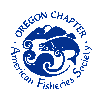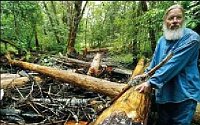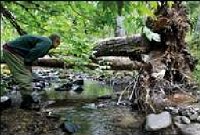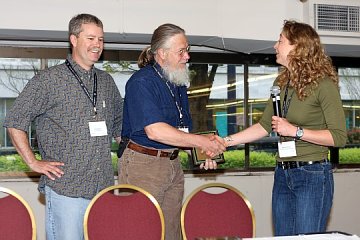~~* The Singing Falls Stream Restoration Project *~~
 ϕ
ϕ
~~* The American Fisheries Society 2008 Team Award *~~
The Oregon chapter of the American Fisheries Society has given the Umpqua National Forest fisheries biologists the 2008 Team of the Year award. Somehow they inadverdantly put my name in ther also :). The following is the award submission, the local USFS media announcement and some photos from the Western Division of AFS conference held in Porland, Oregon during May of 2008.
The American Fisheries Society is composed of professionals, academics, industry, and persons interested in all matters concerning fisheries.
We are humbled and flattered to have been able to participate in this gracious recognition of the efforts to engage in the restoration work carried on our region. I have enjoyed working with the Forest Service fisheries team from Umpqua National Forest. They're a great bunch of hard working gentlemen. These guys are getting stuff done “on the ground” where it matters.
Umpqua National Forest
Contact: Jeff Dose, (541) 957-3301
Umpqua Fisheries Biologists Receive Award

ROSEBURG, OR – May 12, 2008 – At an awards ceremony in Portland on May 7, 2008, four Umpqua National Forest Fisheries Biologists and a Douglas County landowner were recognized by the American Fisheries Society as the “Fisheries Team of the Year”.
Named were Drew landowner Stan Petrowski, Tiller Ranger District Biologists Casey Baldwin and Bob Nichols, and Supervisor’s Office Biologists Todd Buchholz and Jeff Dose.
The award was in recognition of cooperative habitat restoration efforts for wild coho salmon in the upper South Umpqua River basin.
In a message announcing the award recipients, Lance Kruzic, Natural Production Committee Chair, said, “You have been awarded “Fishery Team of the Year” for 2008 by the Oregon Chapter of the American Fisheries Society. Congratulations on work well done!! The Chapter recognizes the hard work that was done by the Team to develop cooperative relationships between federal and private entities. Your work not only benefited the fishery resource, but also had significant social benefits.”
According to Cliff Dils, Umpqua National Forest Supervisor, the award is well deserved by the collaborative fisheries team for all their hard work and creativity in restoring habitat for wild coho salmon while building stronger partnerships.
Oregon Chapter of the American Fisheries Society
Fishery Team of the Year 2008
Social Barrier Comes Down and Coho Benefit
| Calib Baldwin Fisheries Biologist Umpqua National Forest ORAFS member (541) 825-3133 |
Stan Petrowski Landowner/Coho Restorer Singing Falls Drew, Oregon |
| Robert Nichols Fisheries Biologist Umpqua National Forest ORAFS member (541) 825-3100 |
Todd Buchholz Fisheries Biologist Umpqua National Forest ORAFS member (541) 957-3338 |
| Jeff Dose Fisheries Biologist Umpqua National Forest ORAFS member (541) 957-3301 |
 |
Justification
The Upper South Umpqua River supports one of the last remaining inland runs of truly wild coho salmon at the southern distribution of this species’ range. These fish migrate upstream over 200 miles to their spawning grounds in the Cascade Mountains. Most coho salmon runs are found in the short coastal rivers close to the ocean.
Residents and landowners in the Upper South Umpqua feel they have been “burned” by species in need of protection. The spotted owl/timber controversy in the early 1990’s caused great outcry from the community, since timber harvest on federal and private lands was the mainstay of this community. A few years later, Umpqua cutthroat trout and coho salmon were listed under the ESA in the same area. Further land management changes were taken; most notable being the US Forest Service eliminating nearly all of the cattle grazing by local residents on federal lands. All of these actions significantly alienated the community from government agencies and protection of the species and their habitats. The following picture sums up the sentiment of this local community. In their eyes, government and fish equaled bad news and hardships.

Graffiti painted on a government building in the community of the Upper South Umpqua Basin in the late 1990’s. The grattifi essentially states “Democracy? Do cows kill fish? Lets vote- We, the people. This land is we the peoples. We, the peoples, property!”
The communities’ paranoia and lack of interest in saving fish or wildlife started to take a dramatic turn of events in 2004. The story is best told in the following article published June 13, 2007 by the News-Review Newspaper.
Coho comeback
ADAM PEARSON
News-Review
June 13, 2007
DREW — One fish in Joe Hall Creek is all it took for this sleepy community to rethink its relationship with nature and the U.S. Forest Service.
Two fish, three fish — a whole lot of fish later — and residents who were placed in Joe Hall Creek as part live between Tiller and Jackson County now anticipate coho salmon to complete a life cycle in Joe Hall Creek this winter for the first time in 50 years.
“What we’d like to see is thousands and thousands of coho returning to Joe Hall,” said Stan Petrowski, a Drew rancher whose 78-acre spread called Singing Falls sprawls east of Tiller Trail Highway and is split diagonally by Joe Hall Creek. “But realistically, usually there’s a 3 percent return rate.”

Stan Petrowski stands by logs that were placed in Joe Hall Creek as part of a restoration project to fortify coho salmon habitat in the creek. Joe Hall Creek runs through Petrowski’s Drew ranch and he helped the U.S. Forest Service with the project.
Coaxing Joe Hall Creek’s spawning grounds back to their former bubbling ferocity will take a while. The reddened coho salmon, known in the area as the “Thanksgiving fish” for its timely arrival, were once so thick in numbers, old-timers used to say a person could cross the creek by walking on their backs.
And then they seemed to disappear forever — until a few returned to the drainage in November 2004.
At first it was one fish, swimming alone in a pool as if it had lost its way from Elk Creek.
“Well, that’s not going to be very productive,” Petrowski thought of it at the time. But more fish came. In all, seven females and one male returned to plow redds in the gravel and bring the barren creek back to life.
“I was totally taken by it,” said Petrowski, an Angora goat rancher who moved to the area in 1991 with his wife, Alexandra, with whom he spins mohair in their modest cottage.
Elated, he enlisted his neighbors to help with a lookout for more returning coho salmon.
“Before it was all over, you could see my neighbors standing on bridges and over creeks looking for salmon,” he added.
Word of the return spread rapidly. Soon the U.S. Forest Service came calling.
“ 'You want to do something for these fish?' ” a fisheries biologist from the Tiller Ranger District of the Umpqua National Forest asked Petrowski.
“I don’t trust you.” Petrowski replied.
And neither did his neighbors.
Well known in the area is the Forest Service’s long-ago abandoned practice of removing trees and woody debris from rivers and creeks in the 1940s and 50s. The theory was that it improved habitat for anadromous fish. It couldn't have been further from the truth, as it turned out.
“ 'Those idiots are the ones that had us take the wood out in the first place,' ” Petrowski's neighbors would say.
Casey Baldwin, the Tiller fisheries biologist, insisted mistakes were of the past and that old timber harvest methods, which had a debilitating effect on salmon habitat, had largely changed. With the Forest Service’s help, Baldwin said Petrowski could propagate coho salmon on his own land.
Petrowski began to come around. And then there was the connection: He saw the relationship between the salmon on his property with the wildlife in the forest surrounding his home and also with struggling fishermen on the Oregon Coast.
“The whole picture just lit up for me,” he said. “The fact that the fish came back, on my property, made me feel like, 'Hey, this is a responsibility.' ”
One hundred and sixty-one logs and 220 boulders later, Joe Hall Creek and its tributary are primed for the return of the first coho salmon spawned there in half a century.
“I would hope to see 25 fish,” Baldwin said of that return. However, there are many uncontrollable factors, he said, that make any return unpredictable: Out-migrating coho smelt have birds and bass in the South Umpqua and main Umpqua rivers to hide from. Once they make it to the ocean, where they live for about 18 months and fatten up, there’s the real “wild card” — ocean conditions and harvest.

Casey Baldwin, a fisheries biologist for the U.S. Forest Service at the Tiller Ranger District, looks for juvenile coho salmon in Joe Hall Creek last week. Salmon have just begun returning to the Drew-area creek recently.
Whatever the return of those fish that brought Joe Hall back to life three years ago, Petrowski will likely be the first to see it. Sometimes, however, they get by without him seeing them.
Salmon returned to Joe Hall Creek the winter following the year Petrowski noticed them, but were not visible this past winter. But they were in there. On the banks of the narrow creek, small coho fry can be seen zipping around and under large logs that were placed in and around the creek’s channel last summer.
“We got baby coho all in there, so I guess they snuck by me,” Petrowski said.
Those fish and incoming salmon fry from next winter’s spawn will receive a helping hand from Baldwin and Petrowski. Joe Hall Creek tends to run dry by August and has very few pools for fry to find shelter. So the landowner and the biologist will hand- scoop the fry from the creek and transport them to the more robust Elk Creek, a tributary of the South Umpqua River which Joe Hall flows into.
In the future, Joe Hall Creek should begin to rebuild itself with heavy winter flows. There wasn't a heavy rain event last winter to bring down a lot of woody debris and rock to plug-up against the placed logs and boulders, but eventually, the restoration work should pay off in “dividends,” Baldwin said. “Hopefully, everything starts to kick in.”
In the meantime, some of Petrowski’s neighbors have taken their own steps to bring Joe Hall and other area creeks back to their former characteristics with the re- introduction of beavers.
“They're geniuses at what they do,” said Leonard Houston, who, with his wife, Lois, have taken up the cause of beaver reintroduction to the Tiller Ranger District and the rest of Western Oregon so enthusiastically they have created a Beaver Advocacy Committee and pass out fliers and make speeches on their cause.
His neighbor agrees. “We don't need a (Army) Corps of Engineers permit to build a dam, if the beavers are doing it,”
Petrowski said. “Their little ponds become the perfect refuge for salmon.”
END
The project is worthy of recognition because:
• Extreme paranoia of the government was overturned in the community by the
fisheries biologists working on the project.
• Interest in coho salmon restoration started with a couple of people and spread
throughout the community.
• It didn’t matter to the federal biologists that the work would not be done on
federal land, but private land. This demonstrates creativity to get positive
results.
• Restoration work in the stream was completed by a team of landowners (some
who used to hate the government) and biologists working collaboratively.
• The results of this project are two-fold: restoration work has been completed
in Joe Hall Creek; however, more importantly much of the social conflict has
been dissolved.
• The success at Joe Hall Creek has led to stream restoration projects in other
nearby tributaries with similar federal/private cooperation.

American Fisheries Society - Oregon Chapter
Thanks to the generosity of the AFS and the USFS I was able to attend the week long conference in Portland and to receive the award with Mr. Baldwin. The event was attended by 1200 members of the AFS from all over the western USA and the world. It was jam packed with hundreds of presentations and lectures. The grand finally was a two day symposium on stream restoration which was “worth its weight in gold”. Very exciting and meaningful experience.

Calib Baldwin, Stanley Petrowski and the OAFS awards committee chair, Mindy Simons.
top






